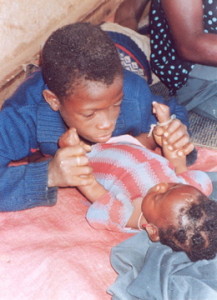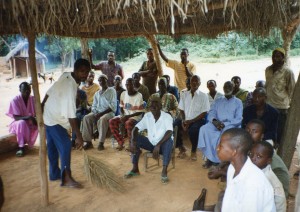Beng-English Dictionary
Beng-English Dictionary (co-authored with M. Lynne Murphy) was published by the Indiana University Linguistics Club in 1995.
One method I used to study the intricacies of the Beng language was to record my interviews in Beng, have trained assistants transcribe the interviews, and then study the transcriptions; in this photo, Bertin Kouadio Kouakou and Augustin Kouakou Yao (then, university students) are transcribing interview tapes, summer 1993.
When I first began working with the Beng, their language had not been documented beyond a short, perfunctory word list compiled by a visiting French colonial officer and ethnographer. I set about learning their language not only to be able to communicate with my Beng hosts and neighbors effectively but, equally importantly, to understand the habits of mind and categories of thought that one can best comprehend through a speaker’s first language.
I did not initially intend to publish a dictionary of the language, but some linguist colleagues who saw my collection of hundreds of index cards noting Beng vocabulary urged me to compile a Beng-English dictionary that could be useful to scholars interested in West African languages, especially those in the southern Mande (sub-)family (a branch of the broader Mande family), to which the Beng language belongs. I was fortunate to enlist the help of M. Lynne Murphy (then a doctoral student in linguistics, and now a Professor of Linguistics and Head of the Department of English Language and Linguistics at the University of Sussex), who contributed her more comprehensive knowledge of linguistics to join in what turned into a fully collaborative project.
 Beng adults and older children speak continually with babies, who are said to fully understand all spoken languages, which they spoke in the afterlife from which they came before their birth into this life (in this photo, Véronique Amenan Akpoueh is speaking with a young relative, August 4, 1993)
Beng adults and older children speak continually with babies, who are said to fully understand all spoken languages, which they spoke in the afterlife from which they came before their birth into this life (in this photo, Véronique Amenan Akpoueh is speaking with a young relative, August 4, 1993)
The dictionary project challenged my co-author and me to consider many ethical factors in making decisions, ranging from which words to include and which to exclude (due to privacy and secrecy concerns), and whether or not to use capitalization (reflecting value priorities), to whether or not to use graphic symbols from the International Phonetic Alphabet in establishing a first orthography. We laid out our thoughts in a talk I presented in Paris, “Considérations éthiques lors de la confection d’un premier dictionnaire : Le cas de la langue beng” [Ethical Considerations in the Construction of a First Dictionary: The Case of Beng] at the International Meeting of the Société de l’histoire et d’epistemologie des sciences du langage and the Laboratoire d’Histoire des Théories linguistiques (Centre national de recherche scientifique/Université Paris 7, 31 January 1997 – 1 February 1997). A version of the talk was published as “Fabrication d’un Premier Dictionnaire de la Langue Beng : Quelques Considérations éthiques” [Construction of a First Dictionary of the Beng Language: Some Ethical Considerations], in Journal des Anthropologues (1997).
To give a sense of the issues we faced in creating the dictionary, I excerpt the introduction to this article:
“The construction of any dictionary carries with it an enormous ethical burden. Sensitive decisions must be made continually, and by definition all decisions exclude some choices even as they include others. Consequently, decisions inevitably have ethical implications that impinge on the way the dictionary will be received by various constituencies of readers. The way that particular words are defined, for instance, or the examples that are used to illustrate the usage of particular words, relates to cultural knowledge as much as to linguistic knowledge. And of course cultural knowledge is anything but neutral, as a growing, interdisciplinary contingent of scholars have discussed in recent years . . . Accordingly, many of the decisions that dictionary compilers must make are likely to raise questions among particular groups of readers–questions to which the dictionary’s author(s) must ultimately supply answers.
If this applies to the construction of all dictionaries, it is especially relevant for a first dictionary that is being constructed for a language about which there was previously little or no written documentation. Such a scholarly enterprise inevitably carries a particularly heavy symbolic weight, hence the ethical risks and dilemmas facing the author(s) of such a dictionary require especially careful attention.
In this paper, we report on just such a project, noting the decisions that we made along various stages of work on our dictionary; the ways that we conceived of the implied ethical dilemmas ahead of time; and our current reflections on the critical decisions we have made, now that a year has passed since the dictionary’s publication . . . We begin with a few words about the Beng language and then go on to discuss, in two sections, a variety of particular issues we faced at each step of the way. The first of these two sections addresses ethical issues related to our representation of the language’s structure. Here, we proceed from least to most vexing and problematic. In the second of these sections we address issues of meaning, especially concerning indigenous constructions of knowledge and secrecy, and their ethical implications for an ethnographic dictionary.”
 This baby is receiving early language lessons from her older brother who is playing a clapping game with her
This baby is receiving early language lessons from her older brother who is playing a clapping game with her
Excerpt from the Preface to the Dictionary:
“While living among the Beng . . . my technique for learning the Beng language centered around a growing pile of index cards on which I recorded each new word learned. Once I’d written down a word, those observing me inevitably kept track of the fact. On more than one occasion I was confronted by the bafflement of a friend when I asked her or him the meaning of a word that they recalled me having already inscribed on one of those cards: if I’d already written a word down, why couldn’t I remember its meaning? Moreover, the Beng themselves are such good second language learners that my slowness–compared to their expected schedule–in learning their language was even more puzzling to them. My friends’ predictions that I’d be fluent in a mere matter of a few months proved, alas, overly optimistic. . . Nevertheless, I persisted, finally reaching a level of understanding that enabled me to converse comfortably, and that has imbued me forever with a visceral love for the sounds of Beng. Even now, as I walk down the street, I often think in Beng; occasionally, I still dream in Beng.”
 Formal meetings such as this require eloquent speeches ruled by intricate speech styles
Formal meetings such as this require eloquent speeches ruled by intricate speech styles
Review excerpt of Beng-English Dictionary:
“Gottlieb, who collected the materials for this dictionary during a fourteen month study among the Beng in 1979-80 and a two month visit in 1985, displays the devotion to her subject in this dictionary, and in a companion work on Beng society and customs, Under the Kapok Tree, which characterizes the true scholar who makes a real contribution to science. . . Gottlieb’s genuine appreciation of Beng culture is epitomized by her explanation of the words which have not been included in the dictionary ‘. . . because their inclusion would violate the secrecy that surrounds their knowledge (p. xi).’ . . . The dictionary itself . . . is well-organized, with the Beng words in bold type for easy scanning. Each Beng entry is first characterized grammatically (n., adj., v., etc.), and, where appropriate, brief but important background information for understanding the sign[i]ficance of the word in Beng culture is included.”
-Patrick C. Ryan, Linguist
Beng-English Dictionary on Bay Language Books.

